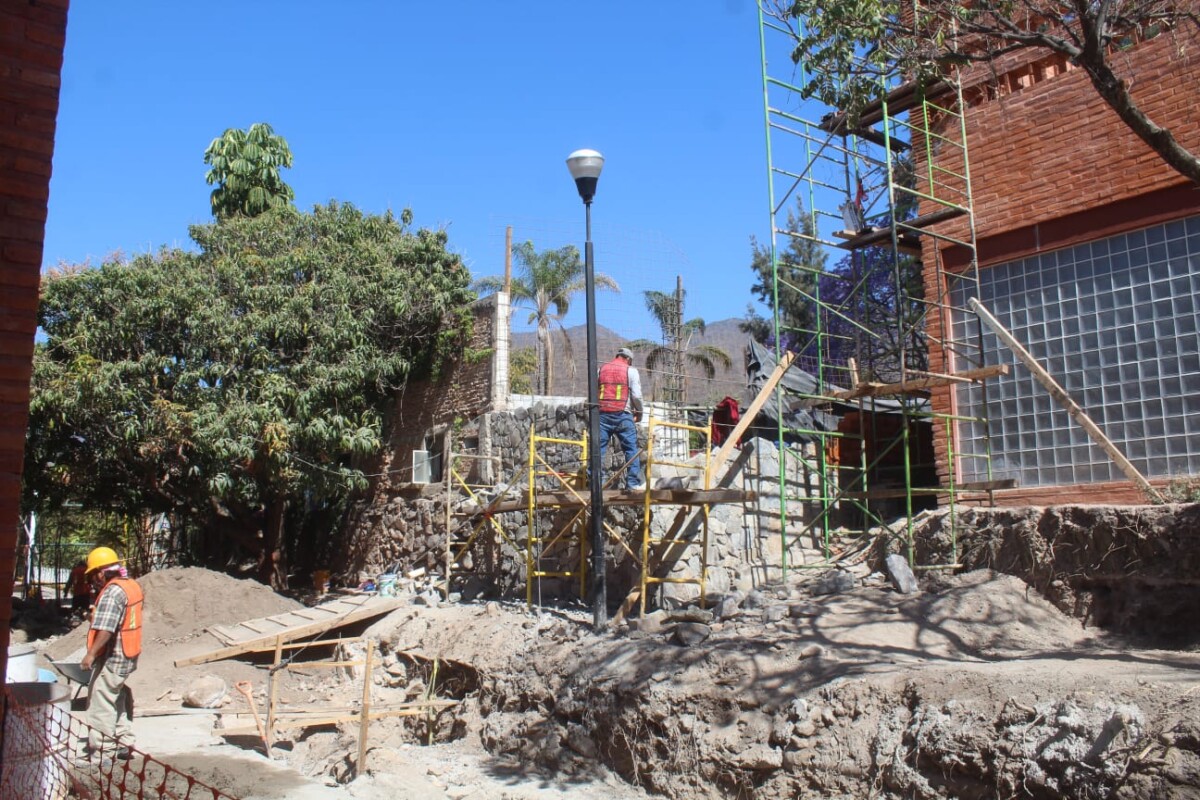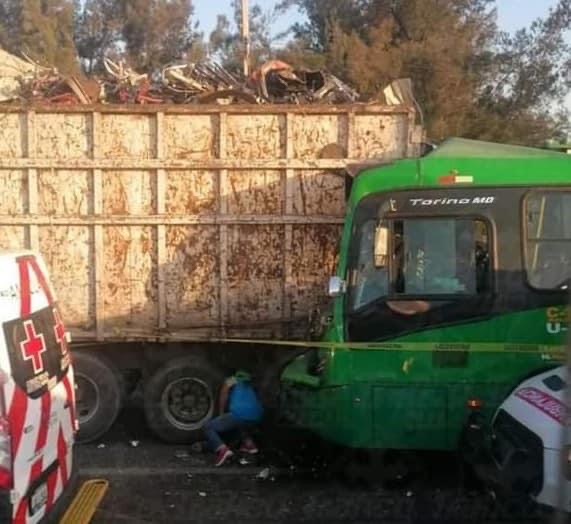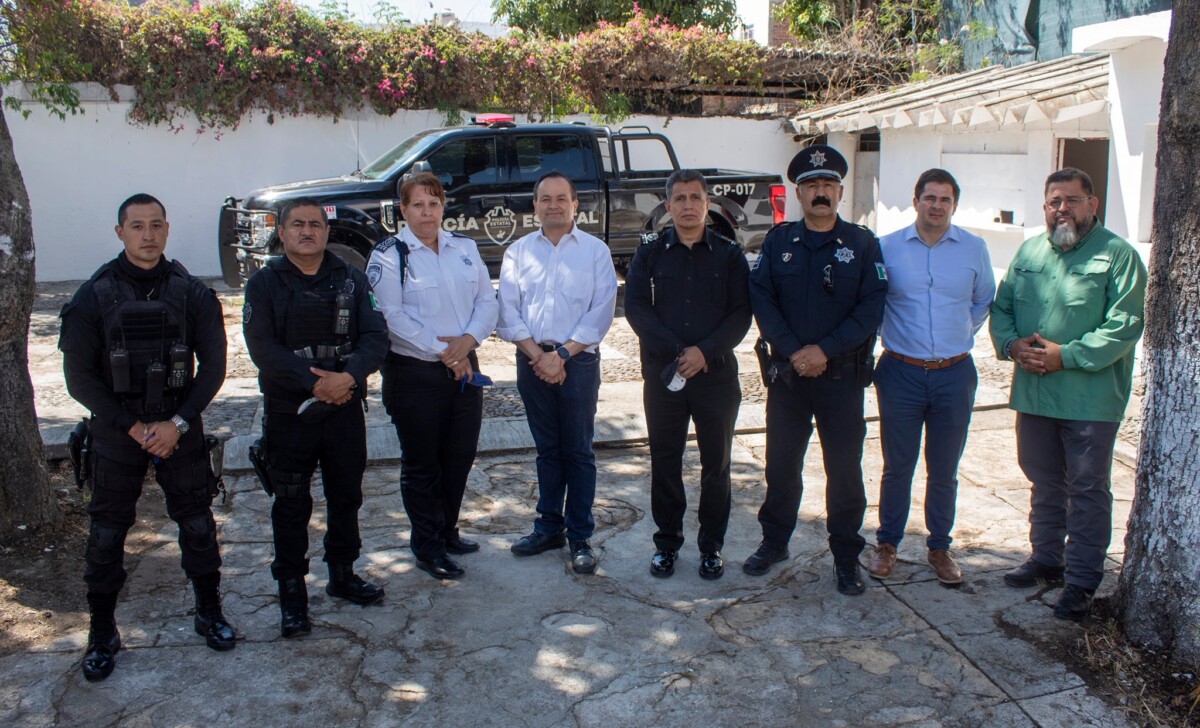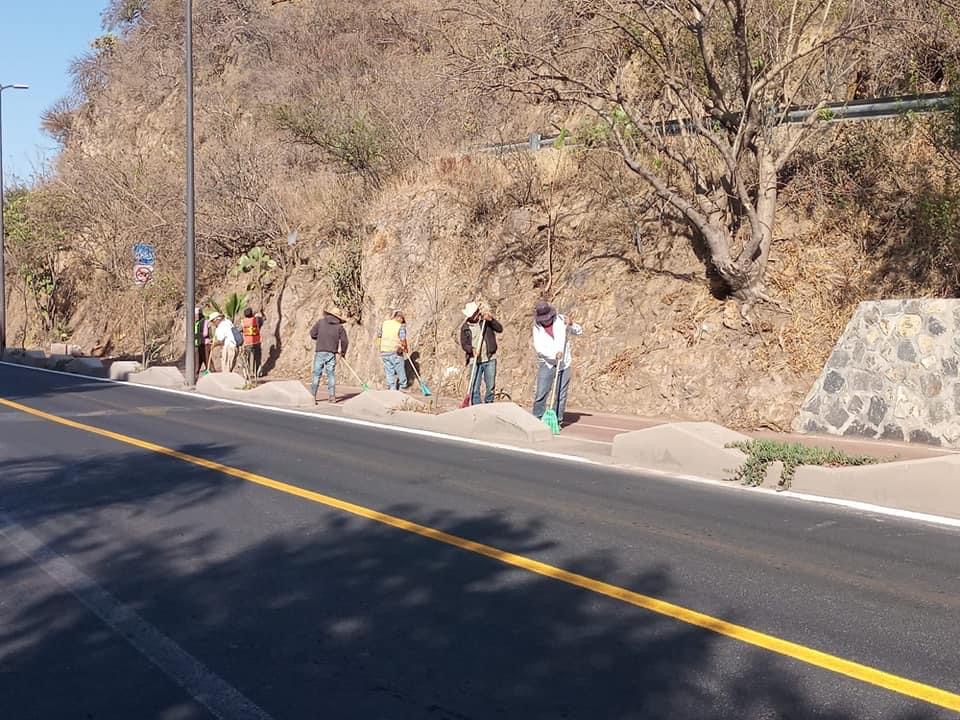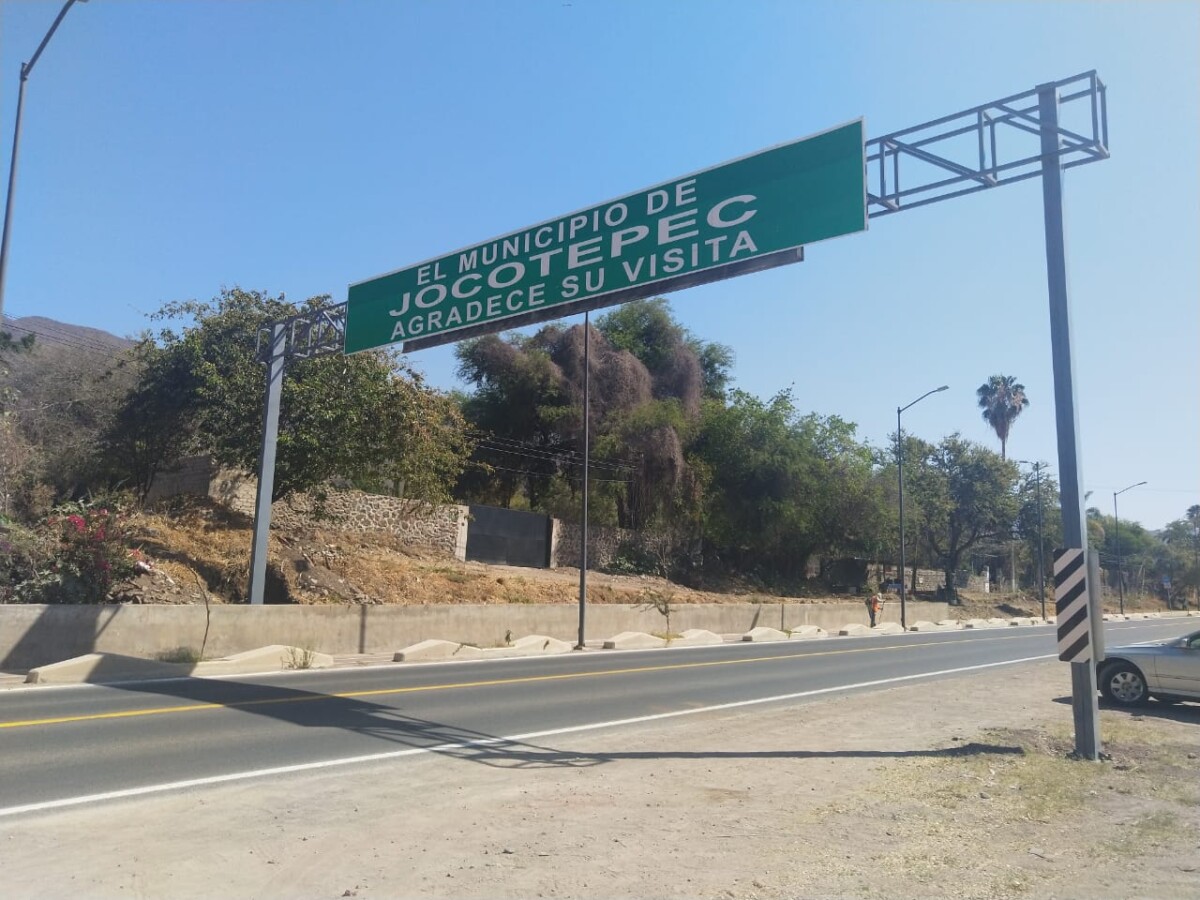noticias
Todo listo para la Consulta de Revocación de Mandato
Redacción.- El día de mañana -10 de abril- se llevará a cabo la primera consulta de Revocación de Mandato a nivel nacional; en el distrito 17 se instalarán 85 centros de votación con 171 casillas, de 8 de la mañana a seis de la tarde.
En el municipio de Chapala se instalarán 24 casillas distribuidas en 12 domicilios; tres en Ajijic, dos en Atotonilquillo, Santa Cruz de la Soledad dos y la cabecera municipal contará con 10.
En el municipio de Jocotepec se instalarán 22 casillas en 11 domicilios: 6 en la cabecera municipal; dos en San Juan Cosalá; uno en Zapotitán de Hidalgo, una en El Molino y otra más en San Cristóbal Zapotitlán.
Cabecera municipal de Jocotepec:
1.-UNIDAD DEPORTIVA NORTE, CALLE ZARAGOZA, SIN NÚMERO, BARRIO UNIDAD DEPORTIVA, ENTRE INVIERNO Y VERANO.
2.-ESCUELA URBANA FEDERAL FRANCISCO I. MADERO, TURNO MATUTINO Y JOSEFA ORTIZ DE DOMÍNGUEZ, TURNO VESPERTINO, CALLE INDEPENDENCIA NORTE, NÚMERO 235, BARRIO LA UNIDAD DEPORTIVA, ENTRE PRIVADA INDEPENDENCIA Y ALDAMA.
3.-CASA DE LA CULTURA, CALLE HIDALGO, NÚMERO 38, COLONIA CENTRO, ENTRE RAMÓN CORONA Y MORELOS.
4.- CENTRO EDUCATIVO DE ATENCIÓN MÚLTIPLE GALLAUDET, TURNO MATUTINO, PRIVADA GONZÁLEZ ORTEGA, NÚMERO 40, COLONIA CENTRO, ENTRE MORELOS Y MIGUEL ARANA.
5.-AUDITORIO MUNICIPAL, CALLE GUADALUPE VICTORIA, NÚMERO 71, COLONIA CENTRO, ENTRE JOSÉ SANTANA Y MIGUEL.
6.-UNIDAD DEPORTIVA SUR , CALLE DONATO GUERRA PONIENTE, NÚMERO 51, BARRIO CRUZ VERDE, ENTRE CALLE HIDALGO Y CALLE PRIMERO DE MAYO.
San Juan Cosalá:
1.- SECUNDARIA FORÁNEA, NÚMERO 58, TURNO VESPERTINO, CALLE VICENTE GUERRERO, NÚMERO 53, ENTRE HIDALGO Y DOMINGUILLO.
2.- JARDÍN DE NIÑOS ESTATAL LUIS DONALDO COLOSIO MURRIETA, NÚMERO 141, TURNO MATUTINO Y NÚMERO 532, TURNO VESPERTINO, CALLE INDEPENDENCIA, NÚMERO 79, ENTRE PORFIRIO DÍAZ Y MORELOS.
Zapotitán de Hidalgo:
1.-JARDÍN DE NIÑOS AGUSTÍN YÁÑEZ, CALLE LÓPEZ COTILLA, NÚMERO 13, ENTRE PEDRO MORENO Y MORELOS.
El Molino:
1.- JEFATURA DEL SECTOR EDUCATIVO, NÚMERO 11, CALLE 16 DE SEPTIEMBRE, NÚMERO 7, ENTRE HIDALGO Y CARRETERA A MORELIA.
San Cristóbal Zapotitlán:
1.- ESCUELA PRIMARIA URBANA NIÑOS HÉROES, NÚMERO 558, TURNO MATUTINO, CALLE RAMÓN CORONA, NÚMERO 2,ENTRE HIDALGO Y LABASTIDA.
Cabecera municipal de Chapala:
1.- Escuela Secundaria Técnica, Calle Circuito Colinas de Chapala, Col Centro.
2.-Secundaria José Vasconcelos No 11, Calle María de Jesús Hernández, Barrio La Parota.
3.-Preparatoria Regional de Chapala , Calle Teófilo Silva, Col. Las Redes.
4.-Escuela Primaria Urbana Eugenio Zúñiga, Calle Cuatro Milpas, Colonia Tepehua.
5.-Jardín de Niños Ricardo Flores Magón, Calle Quetzalcóatl, Barrio de Tepehua.
Ajijic
1.-Jardín de Niños María Montesori, Calle Zaragoza.
2.-Escuela Primaria Urbana, Calle Hidalgo.
3.-Escuela Primaria Marcos Castellanos, Calle Parroquia.
Atotonilquillo:
1.-Jardín de Niños, Calle Benito Juárez No. 56.
2.-Oficina DIF Chapala, Calle Hidalgo.
Santa Cruz de la Soledad:
Escuela Primaria Urbana Leona Vicario, Calle Benito Juárez.
San Antonio Tlayacapan:
12.-Escuela Primaria Federal Cuauhtémoc, Calle Independencia.
La pregunta que se someterá en dicha consulta será: ¿Estás de acuerdo en que Andrés Manuel López Obrador, presidente de los Estados Unidos Mexicanos, se le revoque el mandato por pérdida de la confianza o siga en la presidencia de la República hasta que termine su periodo?.
Por lo que las 171 casillas en el distrito 17, donde pertenecen los municipios de Chapala y Jocotepec, esperan ya recibir a los 272 mil 259 votantes que conforman la lista nominal.
Te compartimos el link de la página oficial del Instituto Nacional Electoral (INE) de Ubica tu Casilla donde podrás acceder tu entidad y sección para saber donde acudir a emitir tu voto:
Buscar en el listado del INE muncipio de Chapala, pág: 337, 338 y 339 / Buscar en el listado del INE municipio de Jocotepec, pág: 341, 342 y 343.
https://portal.ine.mx/wp-content/uploads/2022/03/RM_JAL_21032022_1720.pdf
¿Qué es la consulta popular?
La Revocación de mandato es un instrumento de participación, el cual es solicitado por la ciudadanía para determinar la conclusión anticipada en el desempeño del cargo de la persona titular de la presidencia de la República, esto a partir de la pérdida de confianza.
Esto lo dicta el artículo V de la constitución y la Ley Federal de la Revocación de mandato.
¿Cuál es la pregunta de la consulta de revocación de mandato?
«¿Estás de acuerdo en que a (nombre), presidente de los Estados Unidos Mexicanos, se le revoque el mandato por pérdida de confianza o que siga en la Presidencia de la República hasta que termine su periodo?». Las opciones de respuesta serán:
- A) Que se le revoque el mandato por pérdida de la confianza.
- B) Que siga en la Presidencia de la República».
Los resultados oficiales del proceso de Revocación de Mandato serán exclusivamente los que dé a conocer el INE y, en su caso, el Tribunal Electoral del Poder Judicial de la Federación (TEPJF).
OPINIÓN: FACETAS DE MÉXICO
Campesinos son despojados de sus bienes comunales para la construcción del tren maya. Foto: Cortesía.
Por: Pascacio Taboada Cortina y Jorge Martínez Cedillo.
Los sucesivos presidentes de México a partir de la Revolución, han visto y atendido al esquema de propiedad ejidal y comunal de distintas maneras, aunque coincidentes en la falta de consistencia en los diferentes programas de capitalización e inversión; sin cambios notables en las condiciones sociales, productivas y de intercambio equitativo con los demás sectores. Dejaron “a la buena de Dios” que este segmento de mexicanos viva y progrese –en su mínima expresión—rezagado en lo económico, educativo, sanitario, con cambios tecnológicos esporádicos y sumido en la pobreza, con el agravante de que las tierras repartidas presentan fuertes problemas de degradación por erosión eólica e hídrica.
La degradación de los suelos en áreas de cultivo y en la actividad forestal; en espacios para la producción de todas las especies pecuarias; en selvas tropicales, de acahuales y manglares, ya alcanza 140 millones de hectáreas, con índices de baja productividad y una erosión progresiva en esa superficie. El tamaño del reparto agrario en México, es de aproximadamente 105 millones de hectáreas, lo cual es equivalente a más de la mitad del territorio nacional, con un total de beneficiarios de 5 millones con derechos agrarios.
Actualmente una gran cantidad de este segmento de campesinos, enfrenta problemas con los Títulos de Propiedad Ejidal y Comunal, lo cual deriva en despojos y expropiaciones sin indemnizar a los poseedores de tierras. En los últimos años, miles de pequeños productores rurales, en particular ejidatarios, han resultado afectados con la construcción de proyectos gubernamentales.
Estos son los casos del Aeropuerto de Santa Lucía, también llamado “Felipe Ángeles”; la Refinería de “Dos Bocas”, en Tabasco y, sobre todo, en la construcción de una vía férrea con una extensión de 1,500 kilómetros, siguiendo una línea paralela a la zona costera de los estados de Campeche, Yucatán y Quintana Roo. (De acuerdo con estudios sobre conservación ecológica, estas obras serán un “desastre” para la naturaleza).
El reparto agrario llegó a su fin, hipotéticamente, en 1992, coincidente con la fecha de la última revisión de la Ley Agraria, sin que a estas fechas haya surtido los efectos esperados, porque, en resumen, el campo mexicano está empobrecido. Esa revisión ocurrió “como preparación” para la firma del Tratado de Libre Comercio entre México, Estados Unidos y Canadá, mismo que fue renovado por el actual gobierno, con la condición de que “nadie haga ruido”, porque si bien desapareció PROCAMPO, al programa sustituto le denominan ahora “sembrando vida”, aunque no está diseñado para apoyar a ejidatarios.
En realidad, se ha dejado a este sector de productores la muy alta responsabilidad de producir los alimentos básicos: maíz, frijol y algunas hortalizas, legumbres y frutales para consumo nacional, mientras que la agricultura de exportación está en manos de agricultores privados. En cuanto a producción y exportación de café y azúcar, por tratarse de productos que requieren procesos industriales, la carga productiva corresponde a ejidatarios y pequeños productores, mientras que la industrialización y las exportaciones las realizan empresarios de las industrias respectivas.
Hay que señalar que los esquemas bancarios creados por los gobiernos “emanados de la Revolución”, exprofeso para apoyar a los pequeños productores ejidales y comunales, así como a ganaderos de especies menores, han resultado auténticos fracasos a lo largo de la historia. Todos los bancos y aseguradoras cerraron por falta de rentabilidad y malos manejos financieros. Hoy persiste una Financiera Nacional para el Desarrollo Agropecuario, Forestal y Pesquero, sin rumbo ni recursos.
Con “carteras vencidas impagables”, los deudores se ven en la necesidad de solamente conservar sus parcelas, aunque en muchos casos el gobierno federal ha favorecido grandes expropiaciones ejidales y comunales, con propósitos de creación y extensión de centros turísticos, en particular de estados de la República conectados con zonas costeras nacionales. De la misma manera, gran parte de la industria nacional está asentada en tierras que, en su origen, fueron ejidales y comunales, mientras que también ocupan espacios ejidales los nuevos centros de población y la ampliación de zonas urbanas.
La información sobre el cambio de uso de tierras, seguramente se encuentra en el Registro Público de la Propiedad y del Comercio, o en la Secretaría de Desarrollo Agrario, Territorial y Urbano. Esto, en sus áreas administrativas desconcentradas: Registro Agrario Nacional y Procuraduría Agraria. Se desconoce si estas dependencias realizan informes periódicos sobre sus actividades o, dada la conclusión del reparto agrario, realizan otras actividades relacionadas con el ejido y las tierras comunales.
Desde la “primera Ley Agraria del 6 de enero de 1915”, promovida por don Venustiano Carranza, este ordenamiento jurídico no tuvo efectos inmediatos. Fue hasta la gestión del general Álvaro Obregón que se emitieron los primeros Decretos Expropiatorios, en 1923, para la distribución de tierras entre los campesinos demandantes. De 1920 a 1924 ocupó la Presidencia el general Obregón y lo sucedió Plutarco Elías Calles para el periodo 1924-1928. Sin embargo, Obregón decidió nuevamente ser Presidente de México, pero es asesinado por José de León Toral en San Ángel, en 1928, antes de asumir el cargo.
Estos antecedentes permiten señalar que, a pesar de contar con una Ley Agraria y una nueva Constitución, la de 1917, en la cual esa Ley se convirtió en el Artículo 27, sucedieron varios hechos que impidieron iniciar el reparto agrario masivo a los campesinos sin tierra. Uno de ellos, fue la muerte de don Venustiano Carranza en Tlaxcalantongo, Puebla (1920), a quien sustituyó el general Obregón para el periodo de 1920-1924.
En su oportunidad como presidente, el general Plutarco Elías Calles había tenido un desempeño destacado en cuanto a organización de la administración pública.
Destaca su disposición de formar el Banco de México, en 1925, lo mismo que el Banco Nacional de Crédito Agrícola, el Banco del Trabajo y el Banco Nacional de Crédito Hipotecario y Obras Públicas, también la Comisión Nacional de Irrigación, antecedente de la Secretaría de Recursos Hidráulicos, e impulsó fuertemente la educación y la capacitación técnica entre las juventudes.
En estos resultados, Elías Calles se apoyó para considerar que podría disponer los futuros nombramientos de Presidentes de México, en el marco de un mecanismo que hoy conocemos como “maximato”. Así, ocuparon interinatos en la Presidencia el licenciado Emilio Portes Gil, y los generales Pascual Ortiz Rubio, quien antes ocupaba la Embajada de México en Brasil, y Abelardo L. Rodríguez. Estos acontecimientos retrasaron nuevamente el reparto agrario en México, con la consiguiente frustración campesina y seis años perdidos, dos por cada presidente interino.
A la llegada del general Lázaro Cárdenas del Río como Presidente de México, a fin de gobernar de 1934 – 1940 (primer periodo gubernamental de seis años) le dio un gran dinamismo al reparto agrario en México. Sin embargo, conforme han transcurrido los periodos gubernamentales, los diferentes programas de apoyo no fueron consistentes ni tampoco las autoridades han tenido el cuidado de actualizar los datos fundamentales de los ejidos y comunidades, de sus propietarios y poseedores, con el resultado de que “no faltan vivales” que aprovechan circunstancias para despojar de sus parcelas a quienes las han trabajado muchos años “por herencia” no documentada.
Aurelia Flores Kindergarten entrance to be finished by the end of April
The new entrance to Jardín de Niños Aurelia Flores will be a corridor located between the CETAC high school and the future offices of the Secretaría de Cultura. Photo: Sofía Medeles.
Sofía Medeles (Ajijic).- During his visit to Ajijic on March 25, the Governor of Jalisco, Enrique Alfaro Ramírez, said that it will take approximately one month to provide an entrance to the Aurelia Flores Kindergarten, which was blocked by the remodeling of the Auditorio de la Ribera.
This new entrance consists of a corridor between the Ajijic campus of the Center for Technological Studies in Continental Waters (CETAC) and the building where the offices of the Ministry of Culture will be located. Previously, the entrance to the kindergarten was through the same access as the auditorium.
«I asked them to speed up the work so that the children would not be at risk, because it is under construction. We have already started to free the passage, only the floor needs to be done. I hope that in a month it will be ready and working properly,» said Governor Alfaro Ramirez.
The director of the parents’ committee, Lucia Padilla, advised that they have not been informed about the conclusion of the work being done for this new access to the preschool, in addition they had hoped that the entrance would be a little bigger.
«We wanted to ask for a slightly larger entrance, at least two meters, but we could not talk to the architect and the entrance was left at approximately one meter and 40 centimeters. We have not been told when the work will be finished, or anything else,» she commented.
Previously, several parents complained that, since the construction of the auditorium was in progress, the access through the main door of the auditorium was closed for the safety of the children. The problem has existed since the beginning of on-site classes in August 2021. The parents pointed out that the provisional entrance, which was through the Cruz Azul sports field, was uncomfortable for them and the children, especially in rainy weather and that the work did not seem to be progressing on an entrance exclusively for the students of the school.
In addition, the parents pointed out the poor condition of the classrooms, bathrooms and open spaces of the kindergarten after the pandemic.
Translated by Christalle Dalsted
Bus crash leaves 35 people injured
The bus was embedded in the back of the truck.
Redaction. – The apparent carelessness of a public transport driver left 35 injured and his bus embedded in a junkyard truck. The accident occurred during the afternoon of March 28 on the Chapala-Guadalajara highway, at the height of the so-called «curves of El Tapatío.»
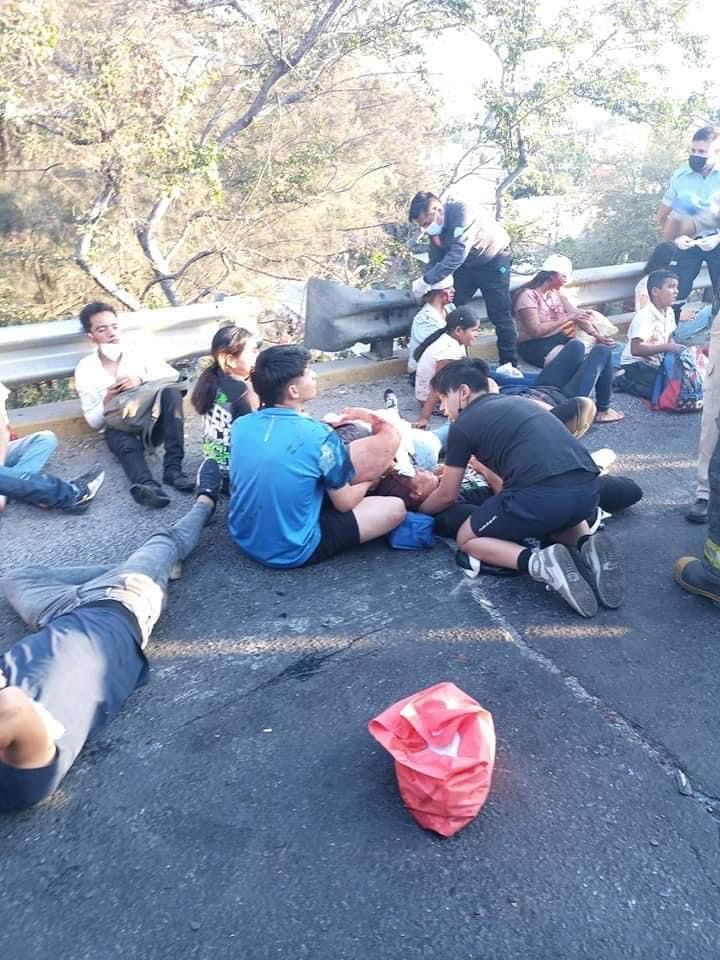
The passengers waited for medical attention on the pavement.
According to the passengers, the driver of the C112 Agaves route was speeding and maneuvering to overtake other vehicles, but on the slope, a truck loaded with scrap metal was driving slowly because of its heavy load, so the public transport driver was unable to slow down enough to avoid the scrap metal truck and struck it from behind.
After the impact, people fell to the floor of the bus and some of them hit the seats hard enough to bend them. The passengers managed to get out of the bus and waited on the roadside for medical attention.
Translated by Sandy Britton
Chapala hands over facilities for State Police barracks
Municipal and state authorities during the handover of the building on the corner of Niños Heroes and Zaragoza streets. Photo: Municipality of Chapala.
Jazmín Stengel.- The former Chapala Police headquarters at the corner of Niños Héroes and Zaragoza streets will now be occupied by the Jalisco Regional Police and the Mobility Department, thanks to the signing of an agreement between municipal authorities and the state. Chapala will continue to pay rent on the building.

Signing of the agreement between municipal and Jalisco authorities for the handover of the former Chapala Police Station. Photo: Municipality of Chapala.
The agreement established last March 25 between Chapala Mayor Alejandro de Jesús Aguirre Curiel and Regional Police Commissioner Abraham Isaac Chávez Velázquez, will allow the State Police to relocate from a small building in La Cristianía Park.
The move gives the State Police better facilities from which to continue working in coordination with the Municipal Police. This helps guarantee the safety of the population just days before the start of the Holy Week and Easter vacation period.
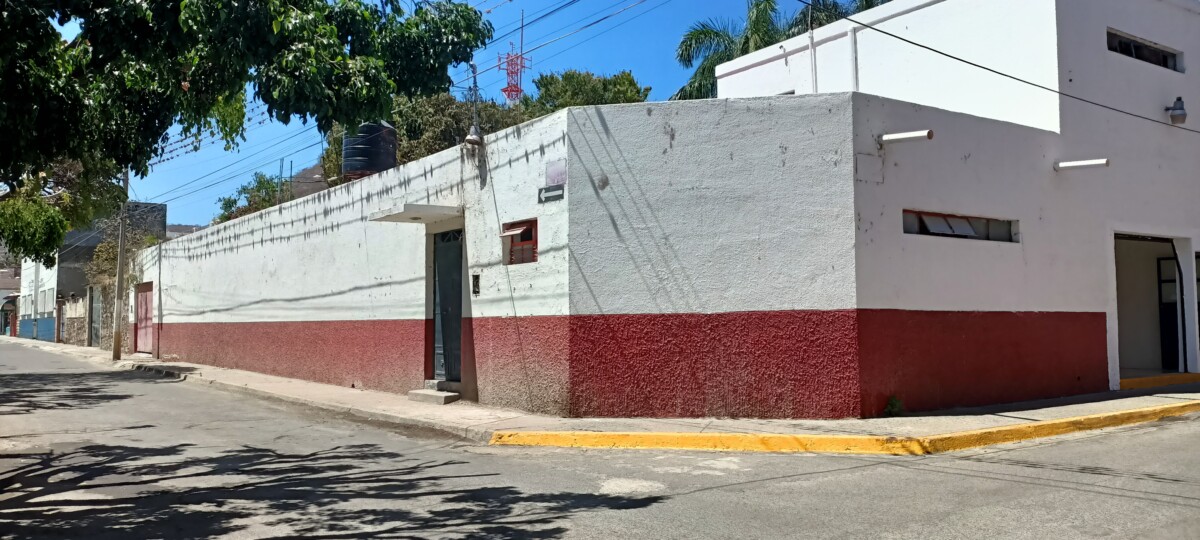
Chapala has rented the building since 1998. Photo: Jazmín Stengel.
Jalisco Secretary of Public Security Juan Bosco Pacheco Medrano said the building is a tool that dignifies police work and helps the State Police coordinate with the municipality to provide peace of mind to both residents and tourists.
“I am pleased to inform you that we have delivered dignified facilities on loan for elements of the State Security Secretariat to have their base of operations,” the mayor said through social media. “The safety and tranquility of the families of Chapala and its visitors is a priority for this government.”

The Regional Police had occupied a small building in La Cristianía Park. Photo: Jazmín Stengel.
Chapala has rented the building since 1998. It was the Municipal Police headquarters until June 2020, when they moved to their new location at the corner of Los Maestros and Isla del Presidio streets. The State Highway Police, with whom the State Police will share the building, began working out of the building a few months ago.
Translated by Mike Rogers
Governor Alfaro’s visit to the lakeside area prompts overdue road maintenance and other work
Dirt, sticks and stones left by the October mudslides were finally removed from the bike path by city hall personnel during the Governor’s visit to supervise public works.
Staff.– Let him come more often! Governor of Jalisco, Enrique Alfaro Ramírez, visited the lakeside area on Friday, March 25th to supervise the local government. His visit not only mobilized extra security, but many municipal employees gave their best effort to make the streets and roads look impeccable. The streets of the Chapala and Jocotepec municipalities looked especially well-maintained. In one day municipal employees performed all the maintenance that had not been done since the administration took over in October.The administration made a clear effort to paint a very rosy picture of the lakeside area for the governor. In Chapala there were no garbage piles to obstruct the governor’s inquisitive eye. The intersection at the junction of the Ajijic highway and bypass had traffic personnel, which is rare even on the busiest weekends. Chapala’s boardwalk, in addition to not having a single piece of garbage, had its green areas watered, and the walkways were washed very early in the morning.
In San Juan Cosalá, Alfaro cycled along the bike path with the presidents of Chapala, (Alejandro de Jesús Aguirre Curiel) and Jocotepec (José Miguel Gómez López). For this occasion, the bike path was finally cleared of sticks, stones, and dirt left by the October landslides.
State workers even replaced the entrance sign welcoming visitors to Jocotepec (from the border with Chapala). Faded road signs were re-painted. If only the governor would come more often so that street maintenance and public services would work this way all the time.
Translated by Amy Esperanto
Municipality of Jocotepec sign is replaced
Jocotepec access sign is replaced
Alma Serrano (San Juan Cosalá).- The municipality of Jocotepec welcomed the Governor of Jalisco, Enrique Alfaro Ramírez with a new sign, for his visit to the Chapala Lakeside on March 25.
Days before, state personnel went to the Chapala-Jocotepec highway at the height of La Mojonera, on the border of the town of Ajijic with San Juan Cosalá, to replace the access sign to the municipality because it was incomplete and with and outdated structure at one of the ends.
Translated by Christalle Dalsted
Reabren más de 2 mil locales tras incendio en Mercado San Juan de Dios
Desde el pasado domingo, el alcalde de Guadalajara, Pablo Lemus, acompañó a los comerciantes en la reapertura de los locales. Foto: Facebook.
Redacción.- Tras el avance de los trabajos de limpieza y reacondicionamiento por el incendio registrado en el Mercado Libertad o San Juan de Dios, el pasado jueves 31 de marzo, más de 2 mil locales ya reanudaron operaciones.
Más del 70 por ciento de los comercios del inmueble reanudaron sus labores; 500 abrieron el domingo y más de mil 500 se sumaron durante el lunes.
Al respecto, el presidente municipal de Guadalajara, Pablo Lemus Navarro, informó que un total de 2 mil 40 locales, de los más de 3 mil existentes, ya abrieron, mientras que los más afectados por las llamas serán reubicados temporalmente.
“Iniciamos el confinamiento de la zona incendiada, que está prácticamente limpia, para poder iniciar los trabajos de reconstrucción. No es sencillo porque tenemos que seguir un proceso de licitación para poder asignar esta obra y esperamos iniciar los trabajos de reconstrucción en máximo 10 días; estamos calculando que pudieran tardar entre 4 y 6 meses”, declaró Lemus.
Este martes inició la reubicación de los espacios afectados por el fuego a la explanada central, los baquetones y parte del estacionamiento del Mercado San Juan de Dios; la plaza de La Estampida y la plaza que se encuentra sobre la calzada Independencia.
Asimismo, se anunció el arranque de la entrega de apoyos económicos que ascienden a 25 mil pesos a los comerciantes afectados de los 426 locales consumidos por el incendio. Serán 10 millones de pesos los destinados por el Gobierno de Guadalajara para este rubro.
Water shortage exacerbated by low water levels; Zaragoza well continues to collapse
The delegate Carlos Vázquez Reyes perceived as «normal» the shortage due to the seasonal low water level, although he acknowledged that it was aggravated by the failure in the well. Photo: File.
Alma Serrano (San Juan Cosala).- The failure of the Zaragoza well pump, together with the dry season, has left the residents of San Juan Cosalá without drinking water.
In this regard, the delegate of the town, Carlos Vázquez Reyes reported that they are already working on the resolution of the failure of the well, which last December recorded a similar failure.
«We just fixed the Zaragoza well in December 2021 and now we have the same problem as before; last time it took three months to fix,» he commented.
Although Vázquez Reyes saw the seasonal shortage as “normal,” he visualized the possibility of digging a new well to the north of the delegation, on Del Cardenal street, to solve the shortage and distribute the vital liquid in a better way.
«This problem is normal for the season because the pipes are clogged with mud and the water does not have adequate flow. Then the water stagnates in those areas and does not reach all the houses. In addition, the pump throws a lot of mud and some pipes are old,» explained the delegate.
Despite the fact that the problem has been going on for more than two months, Carlos Vázquez said that a «fair» distribution of water has been made, since they try to send it proportionally to all the houses, even at night.
Finally, the delegate informed that the corresponding authorities are already working on the failures of the Zaragoza well, although it is not known with certainty when the service will be regularized, so he asked residents to conserve the resource.
«Let’s take care of the water, if you don’t need it, please let it go to someone who does. I know that people do pay for the water, but that does not give them the right to waste it,» he concluded.
Translated by Kerry Watson
Governor Alfaro announced the rehabilitation of the Auditorio de la Ribera will be completed by the middle of the year
Architects and those in charge of the work, explained the works to the Governor of Jalisco, Enrique Alfaro Ramírez. Photo: Sofía Medeles.
Sofía Medeles (Ajijic).- After his March 25 tour of the Auditorio de la Ribera in Ajijic, Jalisco Governor Enrique Alfaro Ramírez, announced that the remodeling of the Auditorio will be completed in approximately 4 months.
Although previously, those in charge of the project had said that they had no date for the beginning of the third and last stage of the renovation, Alfaro Ramírez stated during his visit that it should be finished in four months and the cultural center should be up and running by the middle of this year.
«The last stage includes the entrance space, details in the auditorium and adjustments that had to be made at the end, but more than anything else, the entrance, the pond and specialized equipment,» the governor said.
He pointed out that, although 70 million pesos have already been invested in the project so far, a budget for the equipment for the center has yet to be designated.
«A budget is being developed and we are looking to involve the businesses of Chapala that offered to help. The budget will be ready in the following weeks and we will see if the private initiative will lend us a hand. Surely the equipment will also be ready within the remaining four months,» he added.
At the end of the tour of the facilities of the cultural complex, Chapala municipal president Alejandro de Jesús Aguirre Curiel, thanked the governor for the space, asserting that it will be of great importance for Ajijic, which has many talented performing artists and traditions, so it will be a good place for them to continue developing.
Also present during the governor’s visit were Alejandro Guerrero, one of the architects in charge of the project, Lourdes González Pérez, head of the state’s Culture Secretariat, and congresswomen María Dolores «Lolis» López Jara , and Claudia Murguía Torres.
The rehabilitation work began in 2020 and is part of a state project called «Cardinal Culture», which aims to develop cultural activities outside the capital of Jalisco. The auditorium will not only host artistic presentations of different disciplines, but will also host courses, as well as offices of the Jalisco Ministry of Culture.
Translated by Patrick O’Heffernan
© 2016. Todos los derechos reservados. Semanario de la Ribera de Chapala


